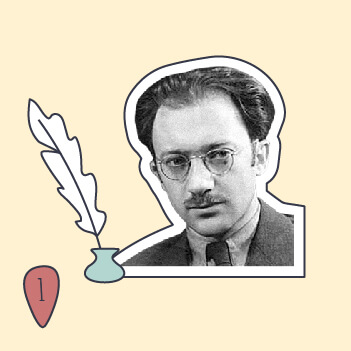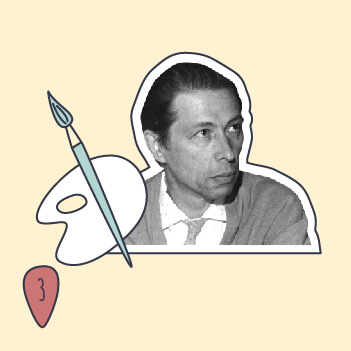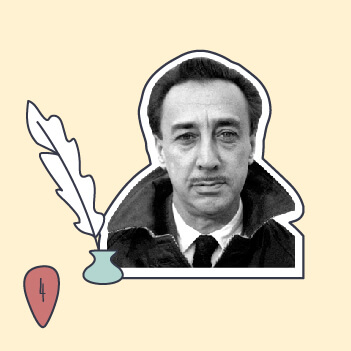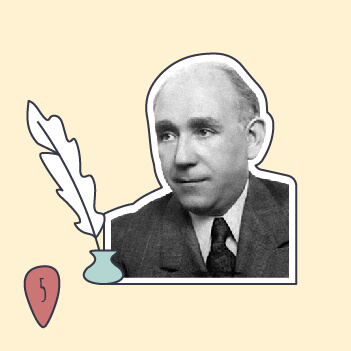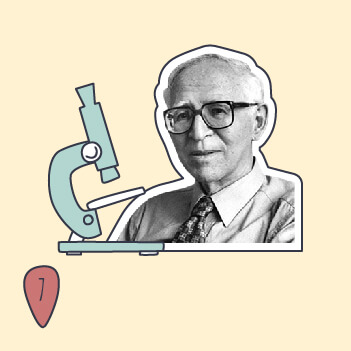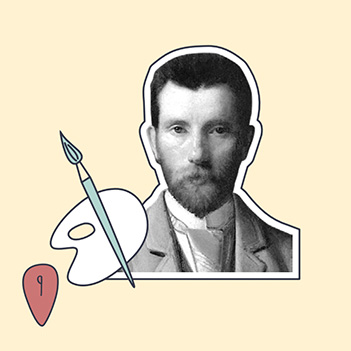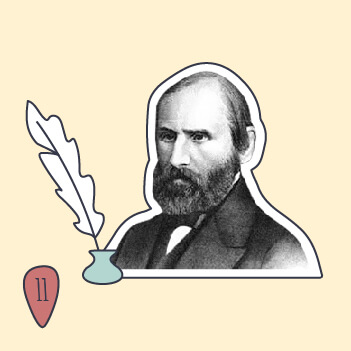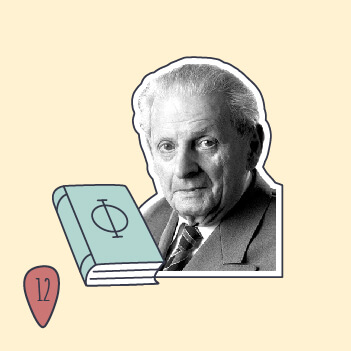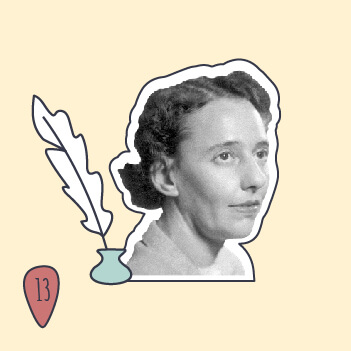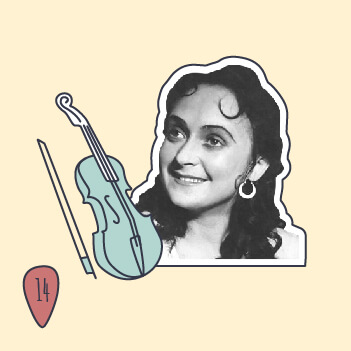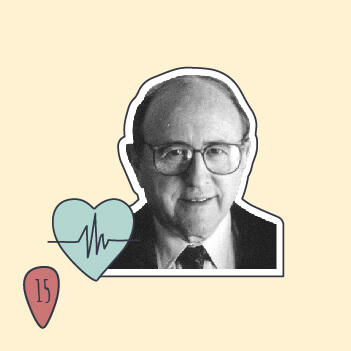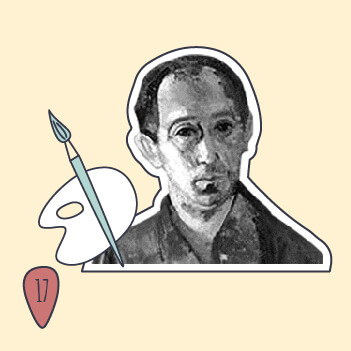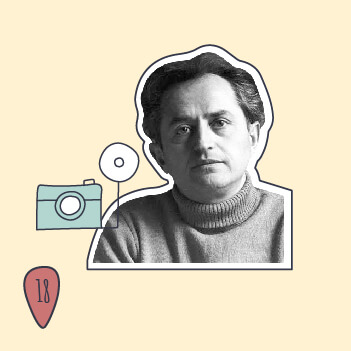Famous Litvaks: Artists and Scientists
In the 19th-20th centuries in the towns and shtetls located in the territory of the present-day Lithuania generations of talented and innovative Litvaks were born, raised and drew inspiration for their future work. These artists and scholars, who grew up in the environment still permeated with a traditional form of religious Judaism, often echoes religious motives in their works, and often relied on the ethics of Judaism in their lives. However, at the same time, they were people of the new era, influenced by the ideas and values of the already secular European culture, who wanted to free themselves from the traditional frames and seek individual forms of self-expression. In this dichotomy between tradition and modernity were born their works that gained global recognition. The creators mentioned in this map ‒ winners of the Nobel or Pulitzer Prizes, authors of artworks that are displayed in world’s most famous galleries, performers of exquisite music ‒ are united by the cultural traditions from which they emerged and by their exceptional talent, which made their name famous beyond their homeland.

1. Abraham Sutzkever (1913-2010)
Born in Smurgainiai, Sutzkever, who later gained global fame as a Yiddish poet, studied literature at Vilnius University during the interwar period. In 1930 he joined the group of Jewish writers and artists called “Junge Vilne”. During the Nazi occupation (1941-1944), he was imprisoned in the Vilnius ghetto and contributed to the activities of the “Paper Brigade” in rescuing the Jewish cultural heritage that was being destroyed by the Nazis. In 1943, as the liquidation of the Vilnius ghetto was approaching, Sutzkever escaped from the ghetto into the woods through sewer pipes and fought in local partisan units. After surviving World War II and returning to Soviet-occupied Vilnius, he became one of the founders of the Jewish Museum in Vilnius, but the museum only operated briefly as the Soviets showed no preference for Jewish culture, so both Sutzkever and his comrades emigrated from Soviet Lithuania, taking with them part of the preserved cultural values. The writer lived in Palestine since 1947, where he continued his prolific creative work. His poems were included in The Anthology of World Poetry, published in 1961 by UNESCO. Abraham Sutzkever died in Tel Aviv at the honourable age of 97.
Location: The building of the library that operated during the existence of Vilnius ghetto, which brought together ghetto prisoners not only for cultural, social, but also for underground activities, has survived to this day in Žemaitijos str. 4. In the basement of the building, the custodians of Jewish culture, including Sutzkever, had set up a hiding place where they hid documents, works of art, books, and other cultural values.
2. Moishe Kulbak (1896-1937)
A classic of modern Jewish literature, one of the greatest and most popular Lithuanian Jewish poets was born in 1896 in Smurgainys. He spent his childhood surrounded by forests and lakes, by the Neris River. Kulbak studied at the cheddar and later ‒ at the famous Volozhin Yeshiva. The poet first began writing poems in Hebrew, later he switched to his native Yiddish and became its poetic virtuoso. In 1916 his first poem, Shterndl, was published. The poem gained such popularity that it became a folk song that is still sung among Yiddish speakers. In 1920-1923, Kulbak participated actively in the activities of the Yiddish Cultural Center in Berlin, but every time he returned to Vilnius, he was also awaited by the entire Jewish community of the city, which would greet him as an internationally famous writer. In 1923 Kulbak wrote the famous poem “Vilne”. It was in Vilnius, the city that inspired the poet, that he became the leader of all Yiddish literary life. The poet taught literature at the Jewish Teachers’ Seminary and Gymnasium, was very much loved by his students, he also collected folklore and staged performances with them, and led his own highly skilled theatre troupe, working as both its director and actor. In 1927 the talented creator was elected president of the World Jewish PEN Club. Unfortunately, Poland, to which Vilnius belonged at the time, did not grant the poet citizenship and he resided there semi-legally, unsure about his future. Maybe that is why in 1928 Kulbak moved to Minsk. As ideological violence broke out in 1937, he was arrested, convicted, and shot in a Minsk prison.
Location: To perpetuate the poet’s memory in October of 2020, the sculpture “Water Carrier” was erected at the intersection of Kėdainių and Dysnos streets in Vilnius. The water carrier is one of the most prominent symbols of Kulbak’s poem “Vilne”. The poet himself lived in the vicinity, in the Old Town, as evidenced by the memorial plaque on the building at Karmelitų str. 5.
3. Rafael Chwoles (1913-2002)
Painter Chwoles was born in 1913 in Vilnius, where he received a religious education in a yeshiva, but the young man’s heart was drawn to art. Every time the opportunity occurred, he took classes in private artists’ studios in Vilnius: he painted portraits, city images, still lifes, and participated in the “Junge Vilne ” group’s activities. When World War II broke out, the artist moved to Russia, where he met his future wife. In 1944 both returned to war-devastated Vilnius, where Rafael captured portraits of Holocaust survivors with painstaking detail and sketvhed surviving fragments of the city’s Jewish quarter. These images are important today in both artistic and documentary terms. Despite his sentiments towards Vilnius, the city of his youth, later in his life Chwoles emigrated to the West, lived in France and died in 2002 at his home in Paris.
Location: In Vilnius, on Tilto str., on the wall of the house No. 13 one can see a memorial plaque testifying that the famous painter once lived here.
4. Romain Gary (Roman Kacev) (1914-1980)
The famous writer, who was born in 1941, spent his early childhood in Vilnius, Pohulanka, in the courtyards and outcrops of the present J. Basanavičiaus Street. While living in Vilnius, on the initiative of her mother Nina, he took private lessons of foreign languages, as well as singing. In 1923 the two of them moved to Warsaw and later to the place of his mother’s dream ‒ southern France. In 1933 Romain entered the University of Provence to study law, at the same time he was working as a waiter, extra in movie sets and a painter in a toy factory. Later he graduated from a military pilot school, took part in air battles at the outbreak of World War II and was awarded the Order of the Legion of Honor. The gifted young man wrote constantly, and although the first creative attempts did not receive much appreciation, he never gave up writing ‒ he kept writing while working and studying as well as during the time spent on the battlefield. After the war, Romain Gary worked as a French diplomat in various parts of the world until 1962. He eventually devoted himself entirely to literary work, published more than 30 novels and became one of the richest people in France and the only writer to win the Prix Goncourt twice: first time for the book “Les racines du ciel “, second time ‒ for “La vie devant soi”, a work he published under a different name. In his works, Romain also talked about his life in Vilnius and fighting at the war and wrote a number of screenplays for films. The writer ended his life tragically ‒ in 1980 after leaving a farewell letter, he shot himself in Paris.
Location: In 2007, in memory of Romain Gary, at the intersection of J. Basanavičiaus and Mindaugo streets in Vilnius, a sculpture “Boy with a Shoe” depicting a nine-year-old Roman Kacev from Vilnius was erected.
5. Chaim Grade (1910-1982)
Chaim Grade was born in 1910 in Vilnius. This was where he received a traditional religious education in the Musar-leaning yeshiva, which was well-known for its strictness. Chaim was a good student but got into trouble because of reading secular fiction and trying to write poetry, so at the age of 22 he finally quit his religious studies and started writing, joining the “Junge Vilne” group of modernist writers and artists. The young man was highly regarded as the most talented member of the group. As a Yiddish writer, he became famous for his prose works “Vilnius Synagogue Yard” and “Silent Minjan”. When World War II broke out, the poet moved to Central Asia, and after the war he returned to Vilnius for a brief period of time, but after seeing the ruined city and not being able to cope with the pain of losing his loved ones, he decided to spend the rest of his life in the United States. This was where he wrote prose, his stories took place in the bygone era when many Jews lived in Eastern Europe. Translated into English, his novel “Rabbis and Wives” was nominated for a Pulitzer Prize. The writer died in 1982 in New York.
Location: Mėsinių str. 11 – Chaim Grade’s residence in Vilnius during the interwar period.
6. Jasha Heifec (1901-1987)
Already at the age of three, the young Jasha Heifec was taught to play the violin by his father. The young violinist spent his childhood at the house in Maironio str. 19. In 1906 he was admitted to the school of the Vilnius Imperial Russian Music Society. Although he was only five and a half at the time, he was immediately placed in third grade due to his remarkable skills. Less than three months after he started school, Heifec already played at a student concert – he gave his first performance on December 7th, 1906. In 1909, a concert of Vilnius Music School teachers took place where an eight-year-old violinist, Heifec, performed F. Mendelssohn’s Concerto for Violin. The money raised during the event was spent on the trip to St. Petersburg, where the young talent entered the conservatory. At that time, the best violinists in the world already recognized him as a virtuoso and a true young prodigy. In 1917, on October 27, the entire Heifec family left for the United States. The same year the talented violinist played his first recital at New York’s Carnegie Hall. Heifec was only sixteen, but he was soon named the world’s top violinist. The violin genius died in 1987, in Los Angeles.
Location: On the occasion of the hundred years of his birth in 2001, on the building Vilniaus str. 25 a memorial plaque was unveiled, testifying that in this house, a former music school, Jasha Heifec himself studied in 1905-1909.
7. Aaron Klug (1926-2018)
In 1926, in the family of a merchant Lozar Klug and a housewife Beile a boy was born, whom the parents called Aaron. The father of the child who was to become the famous chemist from Želva was engaged in animal husbandry, trade, and was learning to make saddles. The young Klug lived in the town near Ukmergė only for the first four years of his life, later his family emigrated to South Africa. At the University of Johannesburg, the young man studied medical sciences, biochemistry, and chemistry. In 1949 Klug started a job as a researcher at the University of Cambridge in Great Britain, and later became a physics doctor. While doing various types of research, he got interested in the viruses that cause polio. Klug developed a methodology for molecular research that enabled better understanding of the processes taking place in cells. In 1982 for this he was awarded the Nobel Prize in Chemistry. Aaron Klug died in 2018 in the United Kingdom.
Location: In 2005, in honour of the famous countryman, a monument depicting an open book and a magnifying glass was unveiled in Želva Town Square (at the intersection of Darius and Girėnas str. and Vilniaus str.).
8. Jacques Lipchitz (1891-1973)
Jacques Lipchitz was born in 1891 in Druskininkai. He was the eldest son in a family of six children. The young man moved to Vilnius in 1909, where he attended the drawing school of the academician I. Trutnev, but after hearing about the gathering of artists in Avilys, the same year he went to Paris to study. In the French capital the young sculptor met Picasso, Rivera and other famous avant-garde artists of the time. It was the acquaintance with Picasso that pushed him toward Cubism. In 1920 Lipchitz held his first solo exhibition in Paris, and eventually his works made their way into exhibitions not only in Europe but also in the United States. Lipchitz’s creations were inspired by the topics of music, family and love, he made sculptures of still lifes, human figures and sketched a lot. After the Second World War, the sculptor also created works commemorating the victims of the Holocaust. In 1973, in his letter to his friend the sculptor Vildžiūnas, he wrote: “I love Vilnius, I remember every corner…”. The famous representative of Cubism died in 1973, on the island of Capri, and was buried in Jerusalem.
Location: The Druskininkai Sculpture Park, where works of local artists are displayed, is dedicated to Jacques Lipchitz (Maironio str. 22).
9. Yehuda Pen (1854-1937)
The famous painter Yehuda Pen was born in Zarasai in the 19th century. After graduating from art studies in St. Petersburg, he founded his own art school in Vitebsk. Many artists, who later gained fame honed their skills at this school, including the world-famous modernist painter and graphic artist Mark Chagal ‒ Pen was his first art teacher. In honour of the artist and his students, exhibitions are constantly organized in Zarasai, filling this lake oasis in Eastern Lithuania with artistic spirit. Pen, who drew and painted images of the life of Lithuanian shtetls, died in 1937 in Vitebsk.
Location: Zarasai Regional Museum and Zarasai Municipal Public Library regularly organize exhibitions of works by Yehuda Pen and his students and tell the story of the artist’s life and work.
10. Chackelis Lemchenas (1904-2001)
Chackelis Lemchenas was born in 1904 in Papilė. The translator, cultural historian and linguist, lexicologist and standardizer of the Lithuanian language drew knowledge from Jonas Jablonskis himself, who was his teacher. After graduating from Kaunas University, Faculty of Humanities, Lemchenas came to teach at the Ukmergė Jewish Science Gymnasium, where he taught the Lithuanian language and later Yiddish as well. Chackelis Lemchenas was convinced that foreigners who wanted to learn Lithuanian well definitely needed Lithuanian language textbooks. During the Second World War, the linguist was imprisoned in the Vilijampolė ghetto and later taken to the Dachau concentration camp. After surviving the war and returning to Lithuania, Lemchenas continued to work as a translator and editor. The first Russian-Lithuanian dictionary compiled by him was published in 1949. The honourable linguist died in 2001 in Vilnius.
Location: In 2016 a memorial plaque to Chackelis Lemchenas was installed in the current Ukmergė Sports Center ‒ the building of the former Great Synagogue (Vienuolyno str. 2).
11. Abraham Mapu (1808-1867)
Abraham Mapu was born in 1808, in Kaunas. Abraham’s father was a melamed (teacher in the cheddar), and Abraham himself was a gifted disciple as a child. The young man believed that proficiency in languages provided one with an advantage in life and therefore learned Latin, German, French and Russian on his own. He was very interested in the history of Israel and in 1853 wrote his famous novel “The Love of Zion”. It was the first work of modern literature on the topics of the Old Testament written in Hebrew. It’s quite probable that the writer wrote his work while sitting on Aleksotas Hill, which later became a popular meeting place with the young Jews of Kaunas. The writer died in 1867 in Königsberg.
Location: One of Kaunas Old Town streets was named after Abraham Mapu in 1919, but the name was changed during the Soviet occupation. The street was given back its original name only in 1989. Today one can see a sculpture that honours the writer in the inner yard of A. Mapu str. 20.
12. Emanuel Levin (1906-1995)
Emanuel Levin was born on January 12th, 1906 in Kaunas. From an early age, the boy spoke not only Yiddish, but also Hebrew and Russian, as his father had a bookstore of Russian language publications. In 1923 the gifted Levin went to Strasbourg and began studying philosophy at the University of Strasbourg, alongside Husserl and Heidegger. After obtaining his doctorate in 1929 Levin began teaching Jewish children at a high school in Paris and later became its principal. In 1930 the philosopher received French citizenship and served in the French army during World War II, working as a translator from Russian and German. At that time, Levin’s relatives were shot dead in Kaunas, on the street right next to their house. In 1963 Levin began teaching at the Universities of Poitiers and Nanterre and continued writing philosophical works. In his works, he analysed difficult-to-describe phenomena, particularly emphasizing the impersonality inherent in the phenomena of fatigue, insomnia, laziness, the horror of being, and the transcendence found in the phenomena of death, fatherhood, and eroticism. The philosopher died in Paris, on December 25th, 1995, at the age of 99 years.
Location: On a wall of a building at Karaliaus Mindaugo ave. 37 in Kaunas a memorial plaque was installed in 2006 to testify that the famous philosopher was born in a building that formerly stood here. In the name Levin was given to one of the streets of Kaunas, a couple of years later the square Putvinskio str. next to the funicular was also named after him. Still, the most important legacy of the scientist and the most direct reminder of his life and work are the philosopher’s books, three of which have been published in Lithuanian so far.
13. Leah Goldberg (1911-1970)
Leah Goldberg was born in 1911 in Königsberg. Later her family moved to Kaunas where Goldberg spent her childhood and she always indicated Kaunas as her place of birth. In 1920 while studying at Kaunas Jewish Gymnasium, the girl began writing her first poems in Hebrew. Her poetry was first published in a local Hebrew periodical in 1926. After graduating from the gymnasium, Goldberg entered Vytautas Magnus University, where she studied German and Russian philology and semitology, and later continued her studies in Berlin and Bonn. At the age of just 22, she completed her doctoral dissertation on the translation of the Bible into the Samaritan language. After returning to Lithuania, Goldberg taught Hebrew language and literature at Raseiniai Tarbut Gymnasium, but the life of the provincial teacher did not satisfy the young ambitious woman. Together with her mother, she emigrated to Palestine in 1935 where she continued her scientific and artistic activities. In 1952, at the Hebrew University of Jerusalem, the poet established the Department of Comparative Literature, which she headed as a professor until her death in 1970. Leah Goldberg’s work was rich and varied: she wrote poetry, prose and books for children, theatre and literary criticism, works of literary studies, translated works of world literature from a number of languages. In 1970, already after her death, Leah Goldberg was awarded the highest award of the country for her literary work ‒ she received the Israel Prize.
Location: In 2020 a portrait of Leah Goldberg was painted on the wall of the house at Kęstučio Street 16b, and her famous poem “Pušys”(Pines) is written next to the drawing in Lithuanian and Hebrew. Until 1935 Goldberg lived with her mother in a nearby house on Kęstučio str. 18, but the house has not survived.
14. Nechama Lifshitz (1927-2017)
Nechama Lifshitz was born in Kaunas in 1927. Nechama’s father Judel Lifshitz worked as a Hebrew teacher at Kaunas Jewish Gymnasium, and later as a doctor at the Independent Lithuanian Armed Forces and Kaunas Military Hospital. Judel Lifshitz became Nechama’s first music teacher ‒ he taught the girl to play the violin and to sing in Yiddish and Hebrew. After the war, the young Nechama studied at what were then Kaunas and Vilnius Conservatories ‒ this is how she began her musical career as an opera soloist. However, the girl could not get the traditional Yiddish melodies and songs of her childhood out of her mind and her heart, so at her father’s urging, she returned to her musical origins and began composing a musical program in Yiddish with like-minded poets and composers. The singer became one of the first composers in Lithuania who dared to revive the memory of the Holocaust in music. Her program included melodies from the Vilnius and Kaunas ghettos. Even after moving to Israel in 1969, the singer never forgot Lithuania, she returned to her birthland several times, at least for a brief visit. The star passed away in 2017 in Israel.
Location: Until the Second World War, Nechama studied at Kaunas Jewish Scientific Gymnasium, at Kęstučio str. 85. It is unexpectedly symbolic that the J. Naujalis Music Gymnasium is located in this building today.
15. Boruchas Lacas (Bernard Lown) (1921)
Bernard Lown was born in 1921 in Utena. Unfortunately, his childhood home did not survive, but the building where Lown studied, located on Vyžuonų str. 7, can still be seen today. The Tarbut School for Jewish Children operated here, where the future scholar also studied. In 1935 Bernard went to the United States with his parents. After graduating from Yale University with a degree in medicine, he worked as a doctor at the Jewish Boarding School in New York. Mr. Lown also headed the Harvard Institute’s Cardiovascular Research Laboratory, the Lown Cardiovascular Center. During the period of 1961-1991 the researcher taught at Harvard University’s School of Public Health in Boston. Bernard Lown became best known in medical science in 1961, when created a defibrillator for the treatment of heart rhythm disorders, but his merits to humanity are not limited to that ‒ in 1980 Lown together with Yevgeny Chiazov from Russia he founded the international doctors’ movement “Doctors of the World Against Nuclear War”, whose activities played a significant role in curbing the proliferation of nuclear weapons during the Cold War. In 1985 he was awarded the Nobel Peace Prize as one of the leaders of this international movement.
Location: Vyžuonų str. 7, Utena ‒ the building of the former Tarbut Primary School in the interwar period, where Bernard Lown also studied.
16. Rudolf Baranik (1920-1998)
The pacifist, pioneer of political abstractionism, Litvak Rudolf Baranik was born in 1920 in Ukraine, however, according to the artist, the roots of his parents and ancestors, of the whole family, were in Anykščiai. As a child, Baranik grew up and studied in Anykščiai, where he graduated from secondary school and discovered his passion for art. In 1938 the young man, who had just come of age, went to the United States to study the humanities, and later on fate led him to the Art Institute of Chicago, while Baranik was already studying in the New York Art Students’ League, and later he continued his education in Paris. The first exhibition of Baranik’s paintings was held in 1951, it was well received in Paris and in the international press. From 1960 to 1990 Baranik led the political movement in New York’s art world and taught at the Prato Institute. Baranik is considered a protest artist and formalist, continuing the tradition of abstract painting, and his painting is described as political abstractionism. His work is included in a variety of global collections, including MoMA in New York. The artist’s work is considered one of the most important works of art at the New York School in the 1960s and 1970s. Rudolf Baranik died in 1998 in the United States, however, in pursuance of his will, his ashes were poured into the rivers dear to him: the Šventoji, the Seine, and others.
Location: In 2012, a name bench with the caption ““A couple of colours is enough for a picture of life” / Rudolf Baranik (1920–1998). A child of Anykščiai. A patriot of Lithuania. World Peace Painter” was installed in the Old Town of Anykščiai in the memory of Rudolf Baranik.
17. Max Band (1900-1974)
Max Band was born in 1900 in Kudirkos Naumiestis. After losing his family early and trying to make a living while he was still a teenager, he settled in Marijampolė and started drawing advertising signs for local shops. The talented young man was soon spotted by the director of a local Jewish gymnasium, who invited him to work as a drawing teacher, and later sent him to study in Berlin. From there, the talented artist travelled to Paris and in 1933 visited the United States, where he painted a portrait of President Franklin D. Roosevelt himself. During the interwar period, Band was well known in Lithuania and held his own personal exhibition in Kaunas. His later works show how the artist noticed simple, everyday details, and the most important models for his portraits were his wife and son. The intrigue of Band’s works lies in their simplicity, in their peculiar melancholic and lyrical mood. A child from the religious family of Eastern European shtetl, he became a world-famous artist, whose artistic heritage is preserved in famous world museums and private collectors’ collections. The artist spent most of his life in California where he died in 1974.
Location: Beatričė Kleizaitė-Vasaris Art Gallery in Marijampolė, located in the restored Hakhnasat Orhim Synagogue building, exhibited the famous works of her talented countryman Max Band for the first time in Lithuania.
18. Izis Bidermanas (1911-1980)
Izis Bidermanas was born in 1911, in Marijampolė, to the family of a porcelain shopkeeper. The family lived in poverty. The prospective photographer graduated from elementary school and entered the gymnasium, but he did not do well at school and he was not keen on becoming a carpenter, as his father dreamed, since he was a youngster of dreamy and creative nature. He fell in love with photography and started attending workshops of Moiše Buchalter, the most famous photographer in Marijampolė at that time. Once he had gotten the basic education in photography, as early as in 1927 he started traveling with his friends through Lithuanian cities and towns, photographing people, various celebrations and locations. In 1930 completely penniless with no personal identification documents and no knowledge of French, Izis emigrated to France ‒ the country of his dreams. A talented young man opened his photo studio in Paris in 1934 where he did portrait photography. During World War II, he participated in the resistance movement, taking pictures of his comrades. In 1941 the rest of the photographer’s family in Marijampolė was killed during the Holocaust, however, Izis not only survived, but literally conquered Paris, made a stunning career and fulfilled his dreams. In 1946 he held his first solo exhibition in Paris. In 1949-1969 he worked for Paris-Match, the major French magazine of the time, Izis took photos of famous writers and painters, and in 1952-1954 he also photographed the emerging state of Israel. In 1952 Izis also conquered the USA ‒ his works were displayed in the exclusive exhibition “Five French Photographers” at the Museum of Modern Art (MoMa) in New York. The famous artist, who never stopped working, died in 1980, at home in Paris.
Location: Izis Bidermanas and his family lived in J. Dailidės str. 7A. The house has not survived, only the place reminiscent of the location of the photographer’s first home is still there ‒ the intersection of the current Vilkaviškio and J. Dailidės streets.
